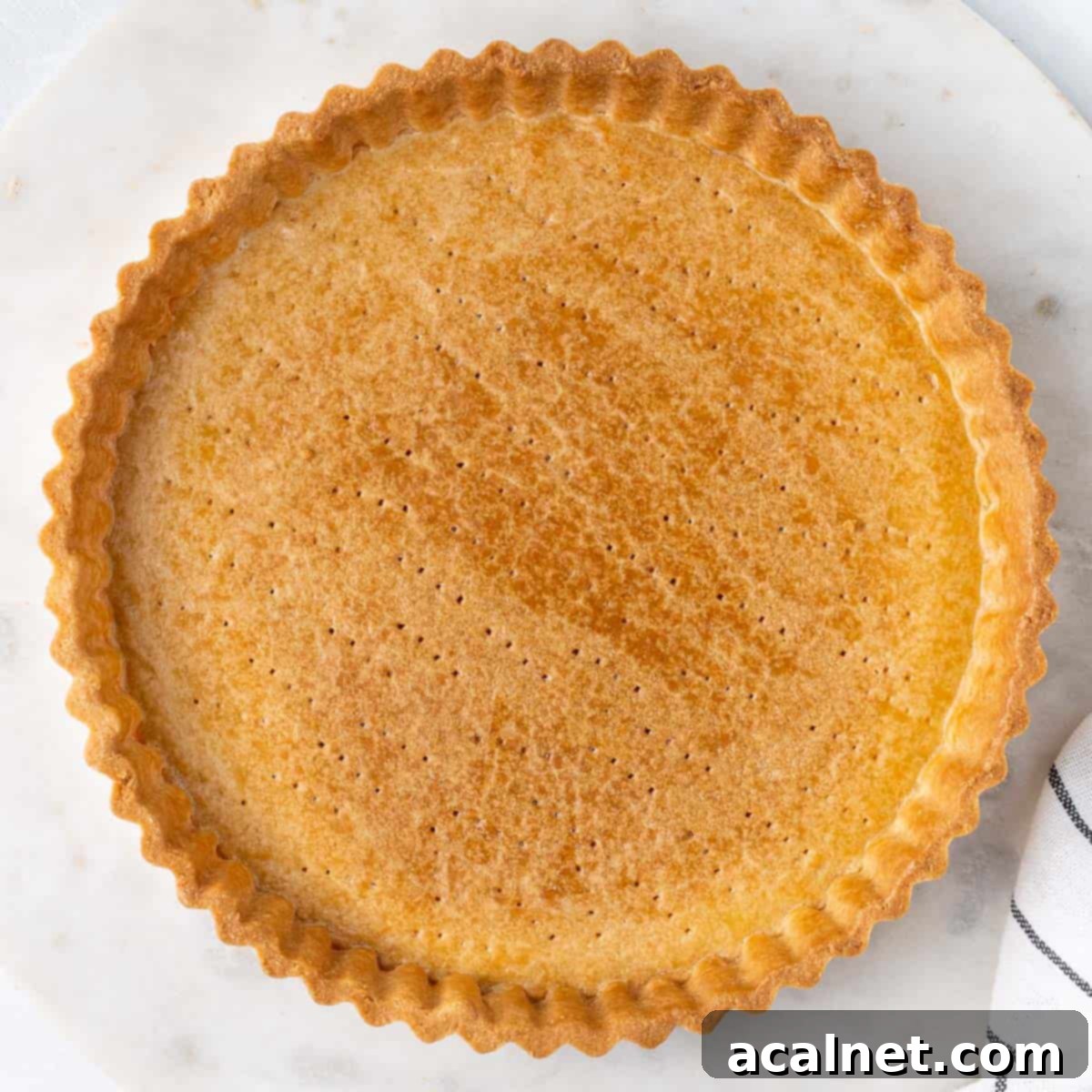Pâte Sucrée Recipe: Master the Art of French Sweet Shortcrust Pastry for Perfect Tarts
Welcome to the definitive guide for making Pâte Sucrée, the exquisite French Sweet Shortcrust Pastry that forms the ideal foundation for an array of magnificent desserts. Whether you’re dreaming of a luscious fruit tart brimming with seasonal berries or a rich, creamy custard tart, this buttery, cookie-like crust provides the perfect balance of crispness and tenderness. Crafted from just six fundamental ingredients, this recipe will transform your baking, ensuring your tarts are not only delicious but also boast a professional, elegant finish.
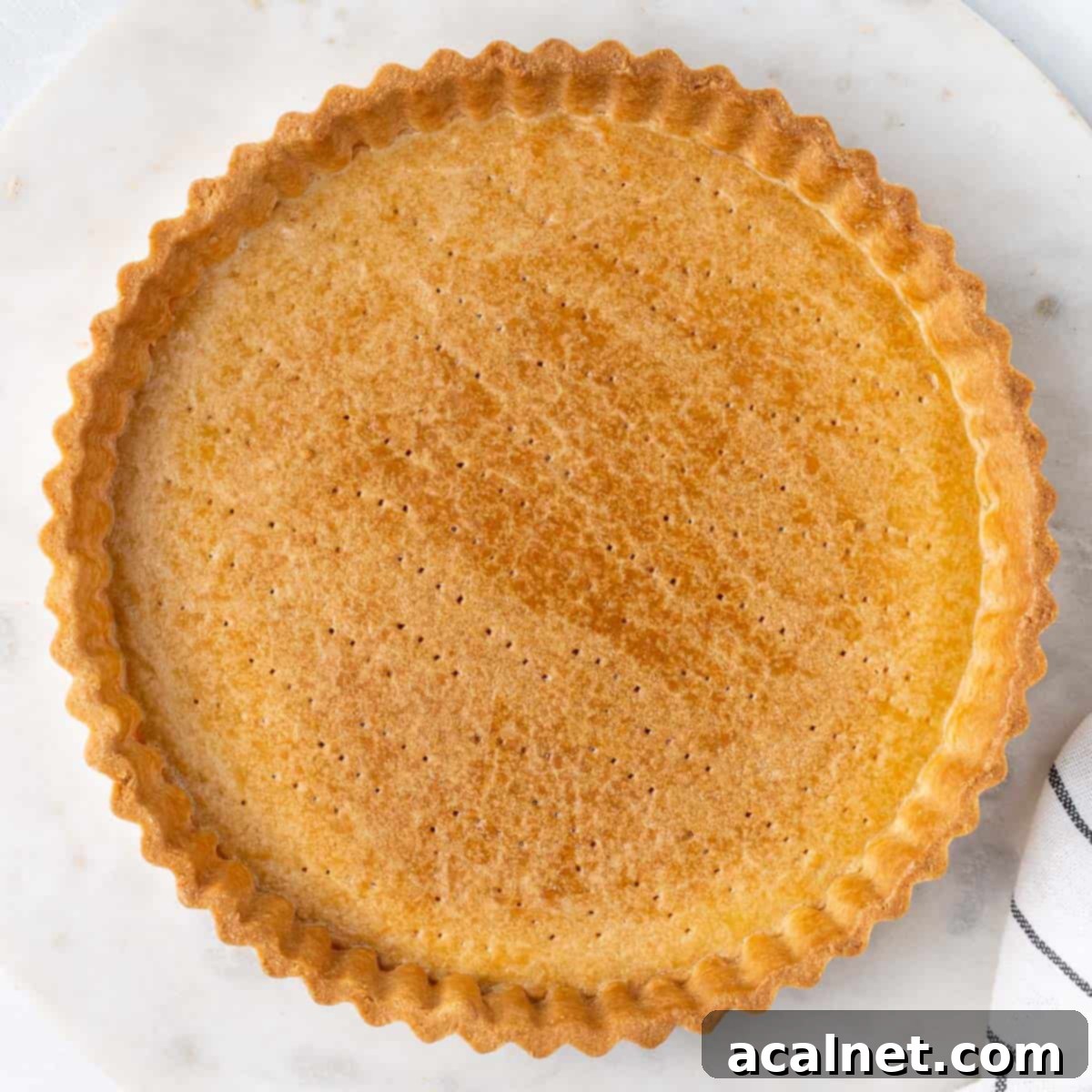
Why You’ll Love This Pâte Sucrée Recipe
This Pâte Sucrée recipe isn’t just a set of instructions; it’s a gateway to effortless, delicious tart making. We adore this recipe for several compelling reasons:
- Simplicity: It relies on only 6 basic, easy-to-find ingredients, making it accessible for bakers of all levels.
- Ease of Preparation: Prepared primarily in a stand mixer, it minimizes hands-on time and effort, ensuring a smooth dough without extensive kneading.
- Make-Ahead Friendly: Both the unbaked dough and the pre-baked crust can be prepared in advance, saving you precious time when entertaining.
- Freezer-Friendly: Extend its shelf life by freezing, allowing you to have a delicious tart crust ready whenever a craving strikes.
- Incredibly Versatile: This sweet pastry crust is a blank canvas for an endless array of fillings. It beautifully complements everything from vibrant fruit fillings to rich, decadent creams.
- Perfect Texture: The resulting crust is deliciously buttery, crisp, and slightly tender, with a delightful cookie-like quality that stands up perfectly to moist fillings without becoming soggy.
This classic French pastry crust is incredibly versatile, making it suitable for any of your favorite fruity, nutty, or creamy fillings. Imagine it filled with a classic Vanilla Crème Pâtissière, a comforting Almond Cream Filling (Frangipane), or even a rich Chocolate Pastry Cream. The possibilities are truly limitless.
Understanding “Pâte Sucrée”: The French Sweet Shortcrust Pastry
The term “Pâte Sucrée” (pronounced “pah-t soo-kray”) literally translates to “Sweet Pastry” or “Sweet Dough” in French. This fundamental component of French patisserie is primarily used for creating elegant tarts, particularly Fruit Tarts. Its distinguishing characteristics are its slightly crispy, tender, and somewhat dense consistency, reminiscent of a delicate sugar or shortbread cookie.
Unlike flakier pastries such as Pâte Sablée (another type of French Shortcrust Pastry) or a standard pie crust, Pâte Sucrée is denser. This density is crucial for its primary application: supporting moist cream or fruit fillings without absorbing excessive moisture and becoming soggy. It maintains its structural integrity and delightful crispness, providing a perfect counterpoint to the filling.
This buttery pastry is delicately sweetened and often incorporates a small amount of almond meal. The almond meal enhances both the flavor and texture, contributing a subtle nuttiness and a more tender crumb. Crucially, it also helps to reduce gluten development, which minimizes the risk of the pastry shrinking during baking. A key difference in its preparation method, compared to many other shortcrust pastries, is the “creaming method” (or “crémage” in French), where soft butter and sugar are creamed together first, yielding a remarkably tender and rich dough.
Essential Ingredients for Perfect Pâte Sucrée
Making a perfect Pâte Sucrée starts with understanding the role of each ingredient. Here’s a breakdown of what you’ll need and why:
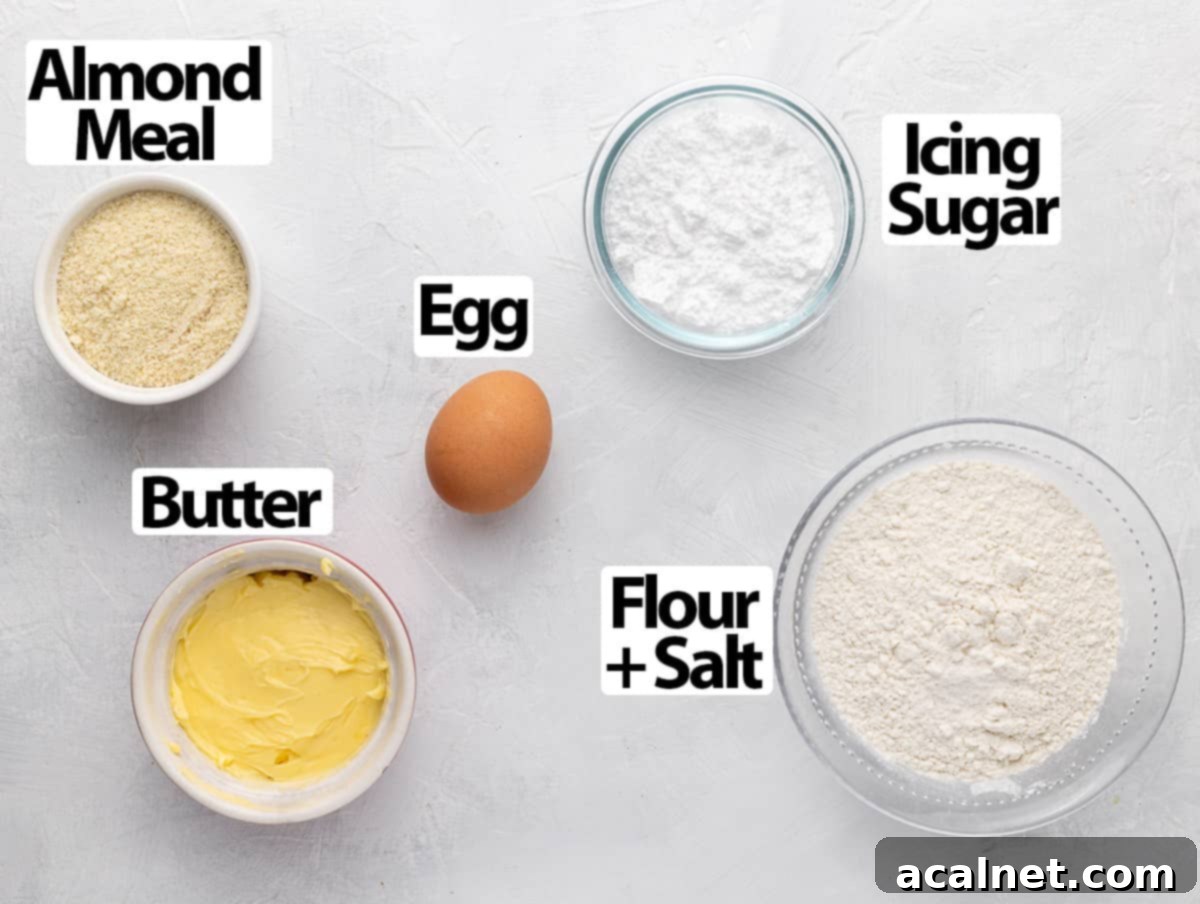
For precise quantities, please refer to the detailed recipe card below.
What is Pâte Sucrée made of:
- Unsalted Butter: This is the star ingredient, providing richness and tenderness. It needs to be very soft and at room temperature (but not melted) to cream properly with the sugar, creating a smooth, emulsified base. Using unsalted butter gives you control over the overall saltiness of the pastry.
- Icing Sugar (Confectioner’s Sugar / Powdered Sugar): Unlike granulated sugar, icing sugar dissolves more readily and helps create a fine, tender crumb with a delicate sweetness. Always sift it before use, as it tends to clump easily.
- Egg: A medium to large egg, at room temperature, is essential. The egg binds the ingredients, adds richness, and contributes to the dough’s structure and golden color when baked. Room temperature ensures it emulsifies smoothly with the creamed butter and sugar, preventing a curdled mixture.
- Almond Meal (Ground Almonds): This ingredient is key to the distinctive flavor and texture of Pâte Sucrée. It adds a lovely nutty aroma and also helps to tenderize the dough by inhibiting excessive gluten development, which prevents shrinkage during baking. If you need a nut-free version, simply substitute the almond meal with an equal amount of additional plain/all-purpose flour.
- Plain / All-Purpose Flour: The primary structural component. Sifting the flour helps to avoid lumps and ensures a light, even texture. This recipe also works well with pastry flour if preferred.
- Salt: A small pinch of fine table salt is crucial for balancing the sweetness and enhancing all the other flavors, making the pastry taste richer and more complex.
Optional Additions & Flavor Variations
While this basic Pâte Sucrée recipe is perfect as is, it’s also wonderfully adaptable. You can infuse it with a variety of flavors to complement your tart fillings:
- Extracts: A teaspoon of Vanilla Extract or Almond Extract can deepen the pastry’s aroma and taste.
- Citrus Zest: Finely grated Orange or Lemon Zest adds a bright, refreshing note that pairs beautifully with many fruit fillings.
- Cocoa Powder: For a decadent chocolate crust, substitute a small portion of the plain flour (e.g., 20-30g) with unsweetened Cocoa Powder. This creates a stunning chocolate sweet pastry.
- Other Ground Nuts: While almond meal is traditional, feel free to experiment with other ground nuts. For instance, finely ground pistachios can create a unique flavor, as demonstrated in this Pistachio Tart recipe.
Step-by-Step Guide: How to Make Pâte Sucrée
Crafting Pâte Sucrée is a straightforward process when you follow these steps carefully. Precision and patience, particularly with chilling times, are your best friends for a perfect result.
Preparing the Pastry Dough: The Creaming Method
Before you begin, ensure your butter is very soft, but not melted. This is critical for the creaming method. Take it out of the fridge at least 30 minutes to an hour before you plan to start, or cut it into small cubes to speed up the softening process.
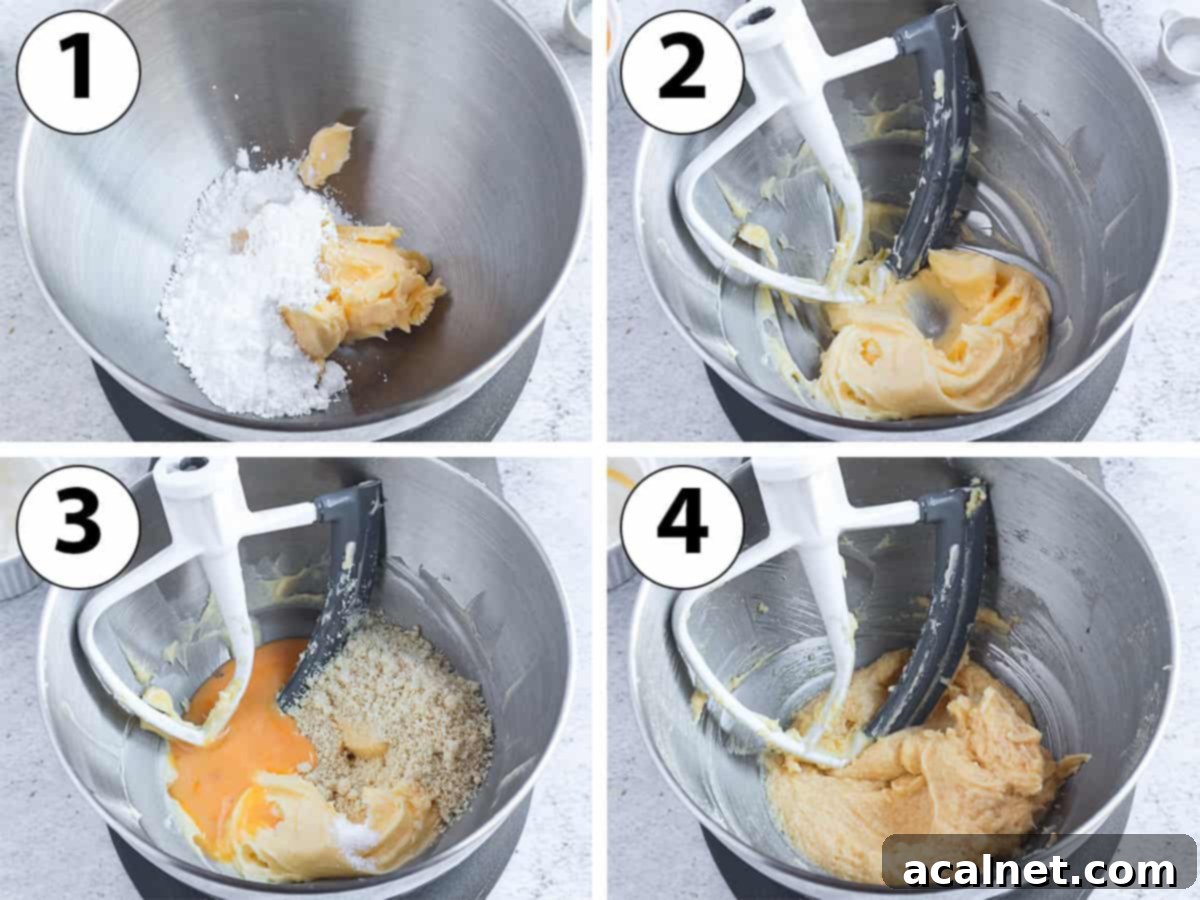
- Cream Butter and Sugar: In the bowl of your stand mixer, fitted with the paddle attachment, combine the very soft Unsalted Butter and sifted Icing Sugar. Cream them together on medium speed for about 2 minutes, or until the mixture is light, creamy, and smooth. Avoid over-mixing at this stage, as we’re not aiming to incorporate a lot of air; just enough to combine and create an emulsified base.
- Add Egg and Almond Meal: Next, add the room temperature Egg (it’s a good practice to lightly whisk it separately first for easier incorporation) and the Almond Meal to the butter-sugar mixture.
- Form a Paste: Mix on low speed until these ingredients are just combined and form a smooth paste. Use a rubber spatula to scrape down the sides of the bowl as needed to ensure everything is fully incorporated.

- Incorporate Flour and Salt: Add the sifted Plain/All-Purpose Flour and the pinch of Salt to the mixer bowl. Mix slowly, just until a rough dough begins to come together. It’s crucial to stop mixing as soon as the flour is incorporated to avoid overworking the pastry, which can lead to a tough crust.
- Form and “Fraisage”: Transfer the pastry dough onto a large sheet of baking paper. Gently bring the dough together into a ball with your hands, then slightly flatten it into a disk.
Understanding Fraisage: Traditionally, a technique called “Fraisage” (or frasage) is performed at this stage. Using the heel of your hand, gently press and smear the dough outwards on your work surface, then gather it back towards the center. Repeat this process a few times. This ensures all ingredients are uniformly blended without overworking the gluten, resulting in a perfectly smooth, homogenous dough and a superior texture.
- Roll the Dough: Place a second sheet of baking paper over the dough. Using a rolling pin, roll the dough evenly into a large circle, aiming for an approximate thickness of 4 mm (1/8 inch). Rolling pins with thickness rings are incredibly helpful for achieving consistent thickness. The dough will be quite soft and easy to roll. Try not to roll it too thin, as this can make it difficult to line the tart pan and increase the risk of cracking during baking. For guidance, place your tart pan over the rolled pastry to ensure it’s wide enough to cover the base and extend up the sides.
- First Chill: Carefully transfer the rolled pastry (still between the baking papers) onto a flat tray. Place it in the fridge to chill and rest for at least 1 hour, or up to 24 hours. This chilling period is vital for allowing the gluten to relax and the butter to firm up, which prevents shrinkage during baking.
Expertly Lining Your Tart Pan
Lining the tart pan requires a gentle touch, especially with a soft dough like Pâte Sucrée. Follow these steps for a perfectly shaped crust:
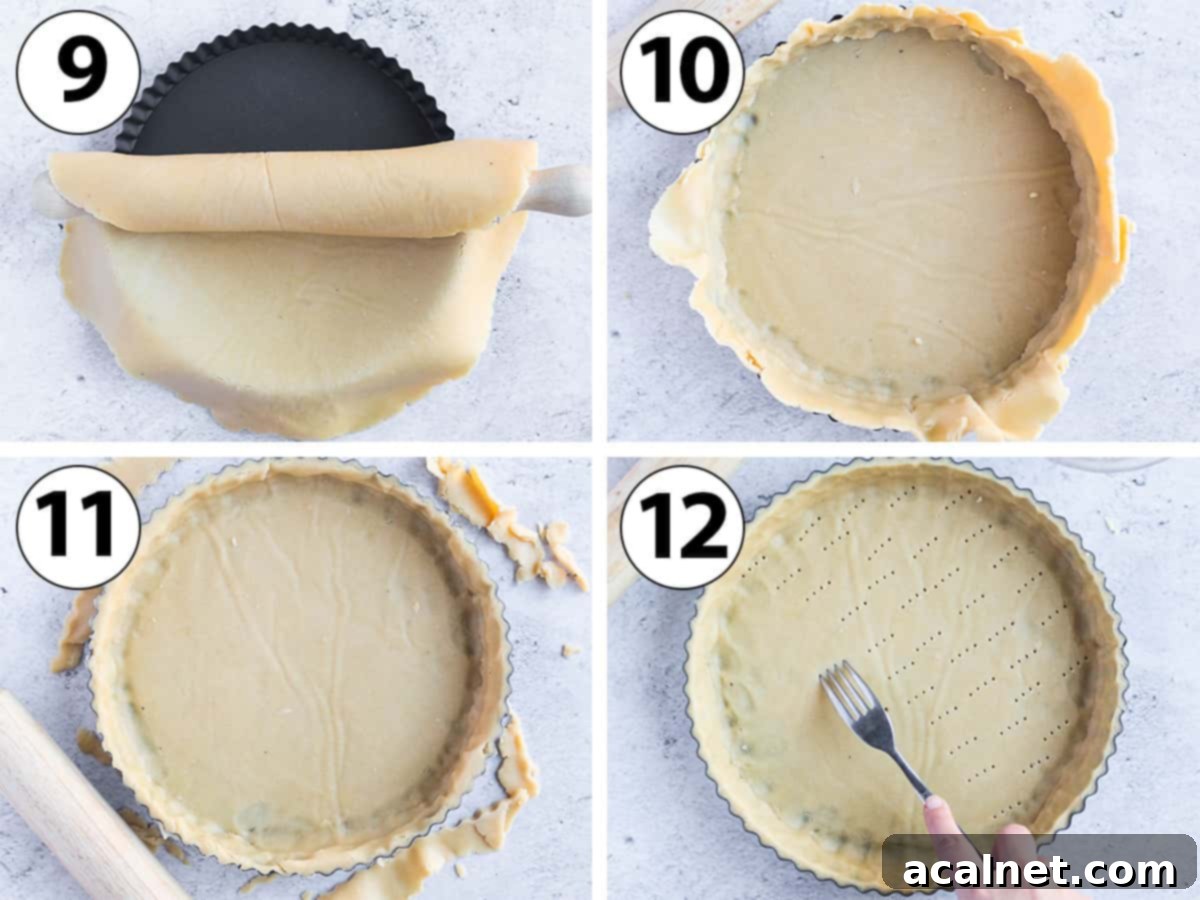
- Prepare for Transfer: Remove the chilled pastry from the fridge and let it sit at room temperature for about 5 minutes to become slightly more pliable. Peel off the top sheet of parchment paper, then gently place it back on. Flip the pastry over and remove the second sheet of baking paper. This double-flip technique ensures the pastry doesn’t stick and is easier to lift.
- Transfer to Tart Pan: Carefully transfer the rolled Pâte Sucrée over your tart pan. For this recipe, a 24-25 cm (9.5-10 inch) tart pan is ideal. If the pastry seems to crack slightly, it might still be too cold or perhaps a little too warm. Adjust by letting it sit a moment longer or chilling briefly.
- Fit into the Pan: Gently press the pastry into the pan, ensuring it fits snugly. Use your fingers to slide the pastry down the edges towards the corners, rather than pushing the base towards the edges. Aim to create a perfect 90-degree angle in the corner where the base meets the side. It’s crucial to press the pastry tightly against all pan edges to eliminate any air pockets, which helps prevent shrinking during baking. Don’t worry if small cracks appear; Pâte Sucrée is very forgiving, and you can easily patch them up with your fingers.
- Manage Dough Softness: Remember that Pâte Sucrée, made with soft butter, is softer than traditional shortcrust pastries. It can become very pliable quickly. If it becomes too soft to handle, simply place the tart pan with the pastry back into the fridge for a few minutes to firm up.
- Trim Excess Dough: Remove any excess dough by rolling your rolling pin over the edges of the tart pan, or by carefully trimming with a small paring knife held parallel to the pan’s rim. If needed, use any trimmed excess dough to patch up any small cracks, holes, or irregularities in the lined shell.
- Second Chill: Place the lined tart pan back in the fridge to chill and rest for at least 1 hour, or up to 24 hours. If chilling for longer than an hour, cover the tart pan loosely with plastic wrap to prevent the pastry from drying out. This second chilling period is just as important as the first for preventing shrinkage and maintaining shape.
- Dock and Preheat: Once chilled, dock the pastry (prick the bottom of the pastry all over with a fork). Preheat your oven to 160°C (325°F). While the oven preheats, place the tart pan with the docked pastry in the freezer for about 10-15 minutes. This quick freeze helps to firm up the butter one last time, ensuring the crust holds its shape beautifully during baking.
- Bake:
- To Par-Bake (Partially Bake): Bake in the preheated oven for 15 to 20 minutes, or until the bottom of the crust feels dry to the touch and just begins to turn golden. This method is used for tarts with fillings that require further baking (e.g., frangipane, custards that bake set). The crust will finish baking alongside your filling.
- To Fully Blind-Bake: Bake for 40 to 45 minutes, or until the crust is lightly golden brown all over. This method is used for tarts with pre-cooked or no-bake fillings, such as Pastry Cream, Diplomat Cream, or chocolate ganache.
I typically do not use pie weights, beans, or rice for Pâte Sucrée. If the dough has been properly chilled and rested, it generally holds its shape well without them.
- Cool: Once baked, transfer the tart shell to a wire rack and allow it to cool down completely before adding your chosen filling. This prevents condensation and keeps the crust crisp.
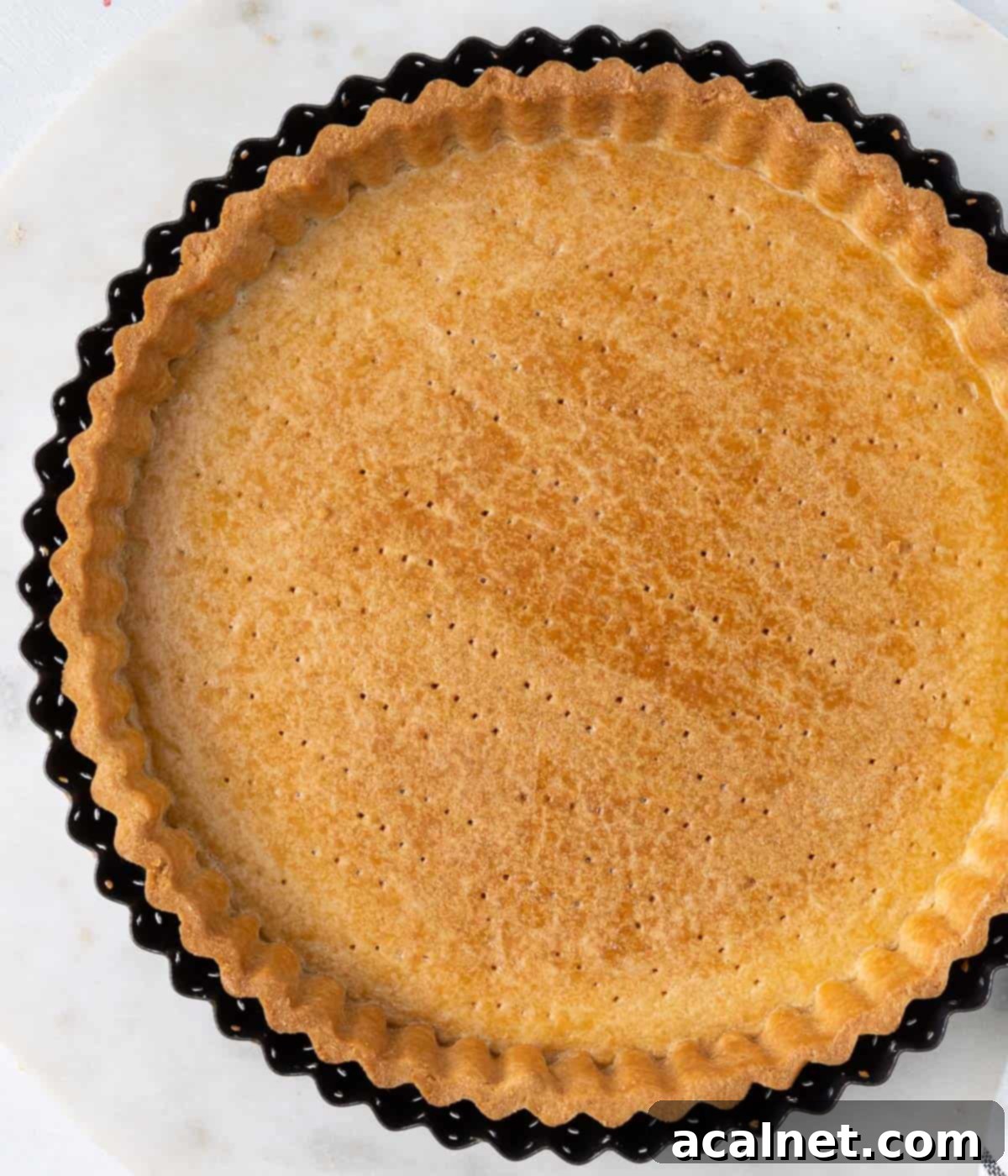
Pro Tips & Troubleshooting for Flawless Pastry
Even experienced bakers encounter challenges. Here are solutions to common Pâte Sucrée issues:
The Pastry is Too Sticky
If your dough feels excessively sticky and difficult to roll, it might indicate an imbalance in ingredients. This can happen due to variations in egg size, butter consistency, or even different brands of flour absorbing moisture differently.
Solution: Gradually add a very small amount of extra plain/all-purpose flour (a tablespoon at a time) and mix until the dough reaches a more manageable, pliable consistency. Be careful not to add too much, as this can make the pastry dry.
The Pastry is Breaking When I Roll It
A crumbly or breaking dough can be frustrating.
Solution: First, ensure you’ve done the “fraisage” step properly, as this helps create a homogenous dough. If the dough still seems a bit dry after thorough mixing and fraisage, it might need a touch more moisture. Add a few drops of very cold water (no more than half a teaspoon at a time) and gently mix until the dough comes together without breaking.
It is Cracking When I Line the Tart Pan
Dough cracking during lining is a common issue that often relates to its temperature.
Solution: The dough might be either too cold (making it stiff and prone to cracking) or slightly too warm (making it too soft and fragile). I recommend removing it from the fridge about 5 minutes before you plan to line the tart pan to allow it to reach the ideal pliable temperature. If it becomes too soft while you’re working with it, simply place the pan back into the fridge for a few minutes to firm up. Remember, Pâte Sucrée is very forgiving; any cracks can be easily patched up by gently pressing and smoothing the dough with your fingers.
The Crust Shrunk or Collapsed in the Oven
This is one of the most common issues with pastry.
Solution: Proper chilling and resting are paramount for Pâte Sucrée. If the pastry was adequately chilled and rested (at least one hour after rolling and another hour after lining the pan), it should not shrink significantly. The chilling periods allow the gluten to relax completely and the butter to firm up. Shrinkage can also occur if your oven temperature is too high, causing the butter to melt too quickly before the structure sets. Furthermore, ensure the pastry is pressed tightly against all edges of the tart pan, eliminating any air pockets between the pastry and the pan. This tight fit helps the crust maintain its shape as it bakes.
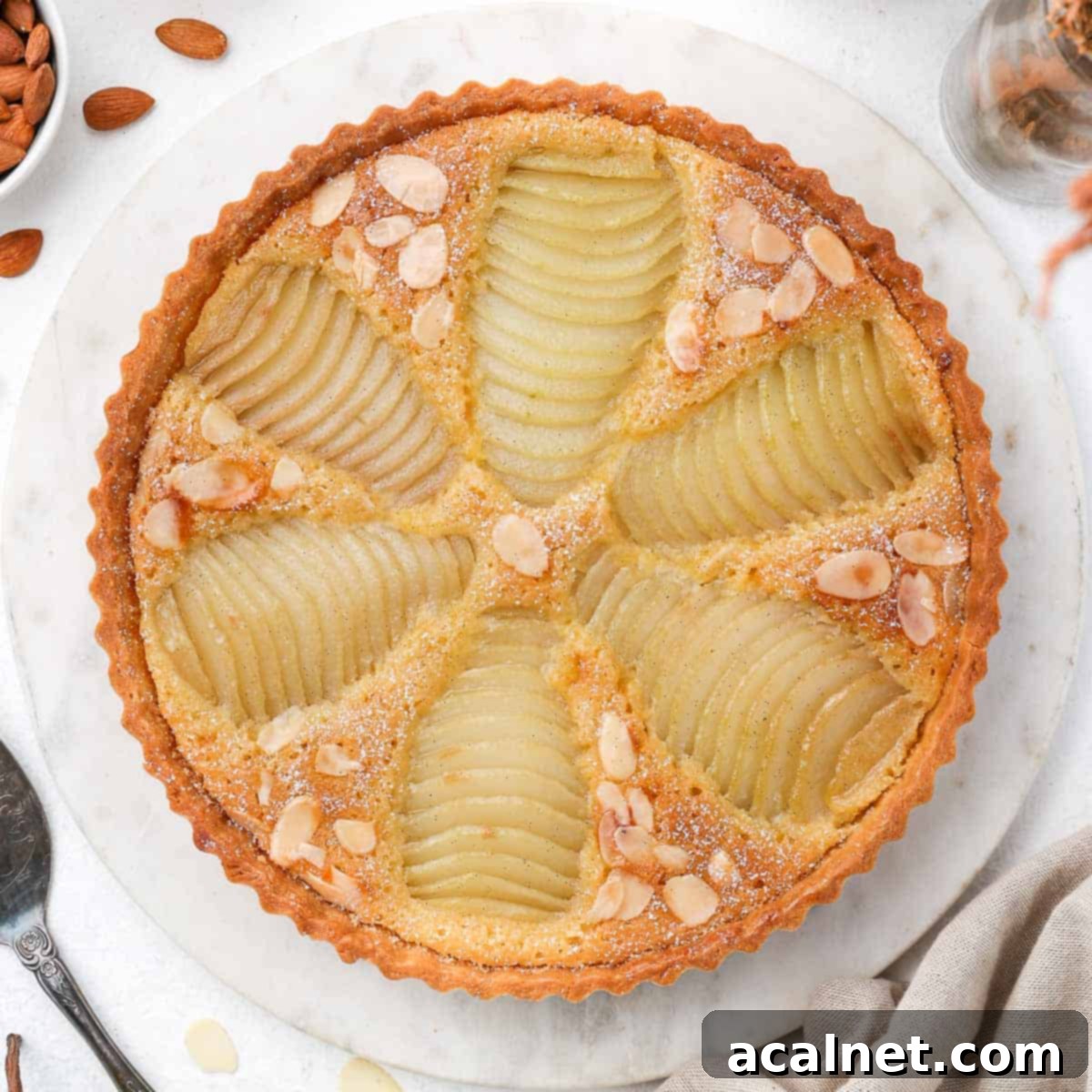
Pâte Sucrée FAQs: Your Questions Answered
The main differences between Pâte Sucrée, Pâte Sablée, and even Pâte Brisée lie in their ingredients, resulting textures, and preparation methods.
Pâte Sucrée: This pastry uses whole eggs, usually no water, and confectioners’ sugar. Its texture is crisp, dense, and richer, almost like a sugar or shortbread cookie. It’s traditionally made with the “creaming method” (crémage), where butter and sugar are creamed first. This richness and density make it perfect for holding moist fillings without becoming soggy.
Pâte Sablée: Often confused with Pâte Brisée, “sablée” means ‘sandy’ in French, which accurately describes its wonderfully crumbly and flaky texture. It’s typically made with egg yolks (sometimes a whole egg), very little to no water, and often granulated sugar or a mix of granulated and powdered sugar. The butter and flour are cut together first in a process called “sablage” to create a sandy consistency before any wet ingredients are added. This method contributes to its delicate, melt-in-your-mouth flakiness.
Pâte Brisée: This is a more savory shortcrust pastry, often used for quiches or savory tarts, though it can also be lightly sweetened for fruit tarts. It typically uses cold butter, flour, salt, and cold water (and sometimes an egg yolk for richness). It’s made by cutting cold butter into the flour, similar to pie crust, to create a flaky texture. It contains very little to no sugar. Its flakiness makes it unsuitable for very moist fillings as it can become soggy easily.
Technically, yes, you can make a sweet pastry in a food processor, but the traditional “creaming method” won’t be applicable.
Food Processor Method: To make Pâte Sucrée in a food processor, you would typically use cold butter (cut into small cubes) and combine it with all the dry ingredients (flour, icing sugar, almond meal, salt). Pulse these together until the mixture resembles fine breadcrumbs or coarse sand. Then, add the egg (lightly whisked) and pulse just until the dough comes together in a ball.
Pros and Cons: This method is quicker and less messy. However, it can be easier to overwork the dough in a food processor, which leads to excessive gluten development and a tougher crust. The texture might also be slightly less tender and rich than a dough made with the creaming method, where the butter and sugar are fully emulsified.
Absolutely, yes! If you aspire to achieve a perfectly shaped pastry case that retains its form without shrinking or collapsing in the oven, two distinct chilling periods are non-negotiable. There are two primary reasons why pastry shrinks or collapses:
1. Gluten Development: When you mix or roll dough, gluten (a protein in flour) develops, making the dough elastic. If the gluten isn’t allowed to relax, it will contract in the heat of the oven, causing the pastry to shrink. Letting the pastry rest for at least an hour after rolling it allows the gluten strands to relax completely. You’ll notice the dough is no longer elastic and doesn’t “pull back” when gently stretched.
2. Butter Melting Too Quickly: If the butter in the pastry is too soft when it enters the hot oven, it will melt rapidly, causing the pastry structure to collapse before it has a chance to set. Chilling the dough thoroughly (especially in the freezer just before baking) ensures the butter is firm. This allows the butter to melt slowly and create steam, which helps maintain the pastry’s structure, resulting in a crisp, well-defined crust.
The method you choose for pre-baking your Pâte Sucrée crust depends entirely on the type of filling you plan to use:
Par-Baking (Partially Baking): This involves baking the crust for a shorter period until it’s set but not fully golden or cooked through. You’ll bake it until the bottom feels dry to the touch, usually for 15-20 minutes.
When to Use: Par-baking is ideal when your tart filling also needs to be baked, such as an Almond Cream Filling (Frangipane) for a pear or apricot tart, or a custard that will set in the oven. The crust will complete its baking process alongside the filling, preventing it from over-baking or becoming too dark.
Fully Blind-Baking: This means baking the tart crust completely until it is golden brown and fully cooked, typically for 40-45 minutes.
When to Use: Fully blind-baking is necessary for tarts with fillings that are already cooked, uncooked, or require no baking. Examples include Pastry Cream, Diplomat Cream, fresh fruit arrangements, chocolate ganache, or lemon curd. The pre-baked crust is then simply filled and chilled (or served immediately), without further oven time.
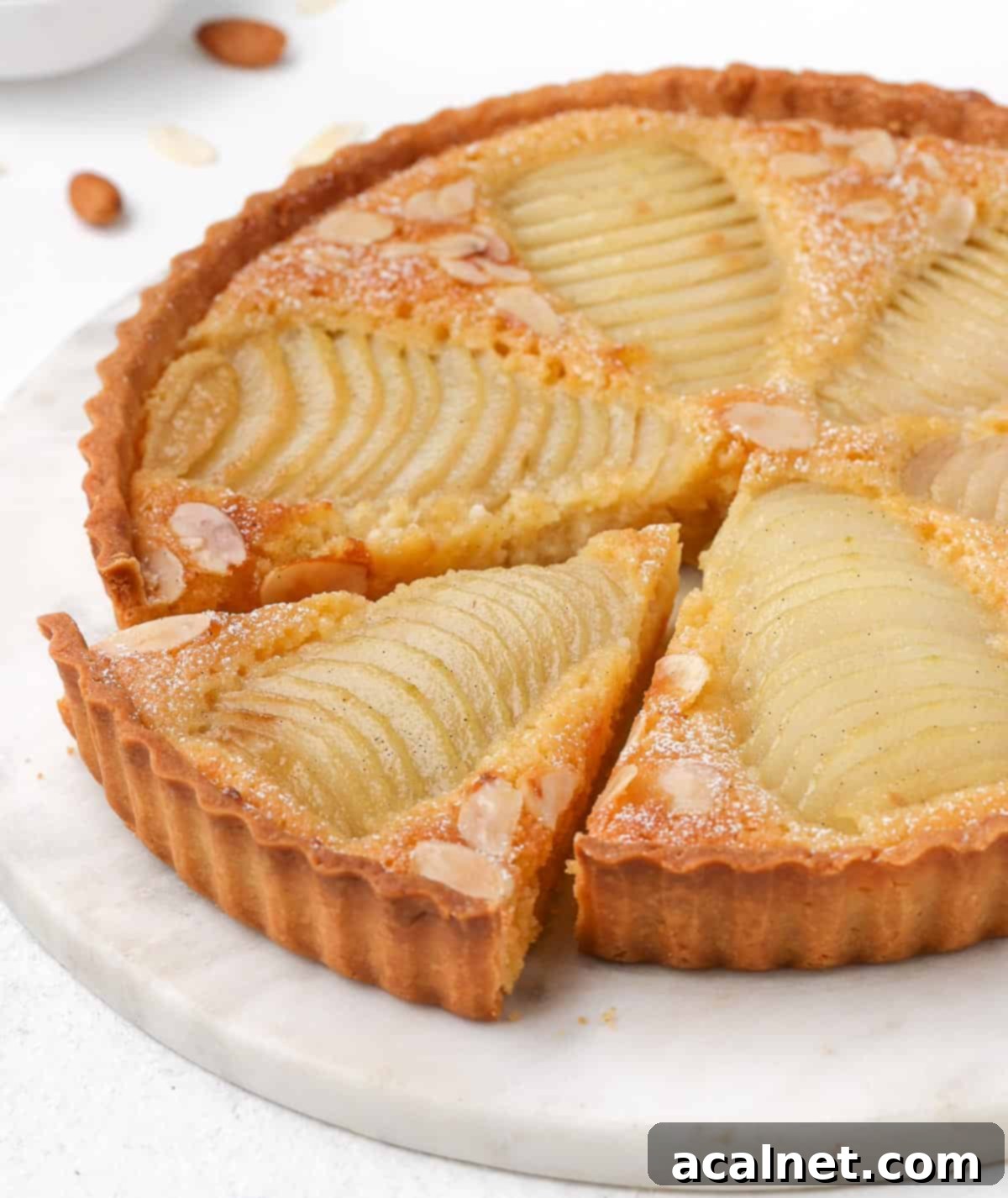
Delicious Ways to Use This Pastry
This versatile Pâte Sucrée is the perfect base for an endless array of sweet creations, especially those featuring creamy, custard, or fruit fillings—whether fresh or baked. Here are just a few ideas to inspire your next baking adventure:
- French Apple Tart: A timeless classic that highlights the crisp pastry against tender, spiced apples.
- Pear Frangipane Tart: The nutty almond cream pairs exquisitely with juicy pears and the buttery crust.
- Strawberry Custard Tart: Fresh strawberries atop a rich, vanilla custard, all nestled in a perfect Pâte Sucrée shell.
- Rhubarb and Custard Tart: The tartness of rhubarb is beautifully balanced by sweet custard and the pastry.
- French Orange Tart: A bright, citrusy delight that truly shines with this sweet crust.
- Parisian Flan: A simple yet elegant French classic, perfect with a sturdy Pâte Sucrée base.
- Lemon Curd Tart: The tang of lemon curd is wonderfully complemented by the sweet, crisp pastry.
- Apricot Frangipane Tart: Similar to the pear tart, this highlights the sweet-tart apricots with almond cream.
- Passion Fruit Tart: An exotic and vibrant choice for those who love bold flavors.
You can also easily adapt this recipe to make smaller, individual portions. Use this versatile pastry to create charming Mini Tart Shells for various mini tarts, such as Pear Frangipane Tartlets, delightful Mini Fruit Tarts, or elegant Strawberry Custard Tartlets, perfect for entertaining or individual servings.
Storage & Freezing Tips for Pâte Sucrée
One of the many benefits of Pâte Sucrée is its excellent storage and freezing capabilities, allowing you to prepare ahead and enjoy fresh tarts anytime.
- Un-baked Dough in the Fridge: The un-baked dough can be stored in the refrigerator for up to 24 hours. You can either keep it rolled flat between two sheets of baking paper or already lined inside your tart pan and tightly covered with plastic wrap to prevent it from drying out.
- Baked Crust at Room Temperature: Once baked and completely cooled, an empty tart shell can be stored at room temperature for about one day. Ensure it’s thoroughly cooled, then wrap it well or cover it properly to protect it from moisture and air, storing it in a cool, shady spot.
- Freezing Pâte Sucrée: This pastry freezes beautifully for up to 3 months. While you can freeze it after baking, I highly recommend freezing it raw for the best possible taste and texture upon baking.
- Freezing Unbaked: For convenience, it’s best to line the pastry in your tart pan before freezing. This way, it’s pre-shaped and ready to go. Wrap the entire tart pan (with the pastry inside) tightly with plastic wrap and then aluminum foil to prevent freezer burn.
- Baking from Frozen: When you’re ready to bake, simply place the frozen, unbaked tart shell directly into your preheated oven (no need to thaw!). You may need to add an additional 5-10 minutes to the baking time compared to chilled dough.
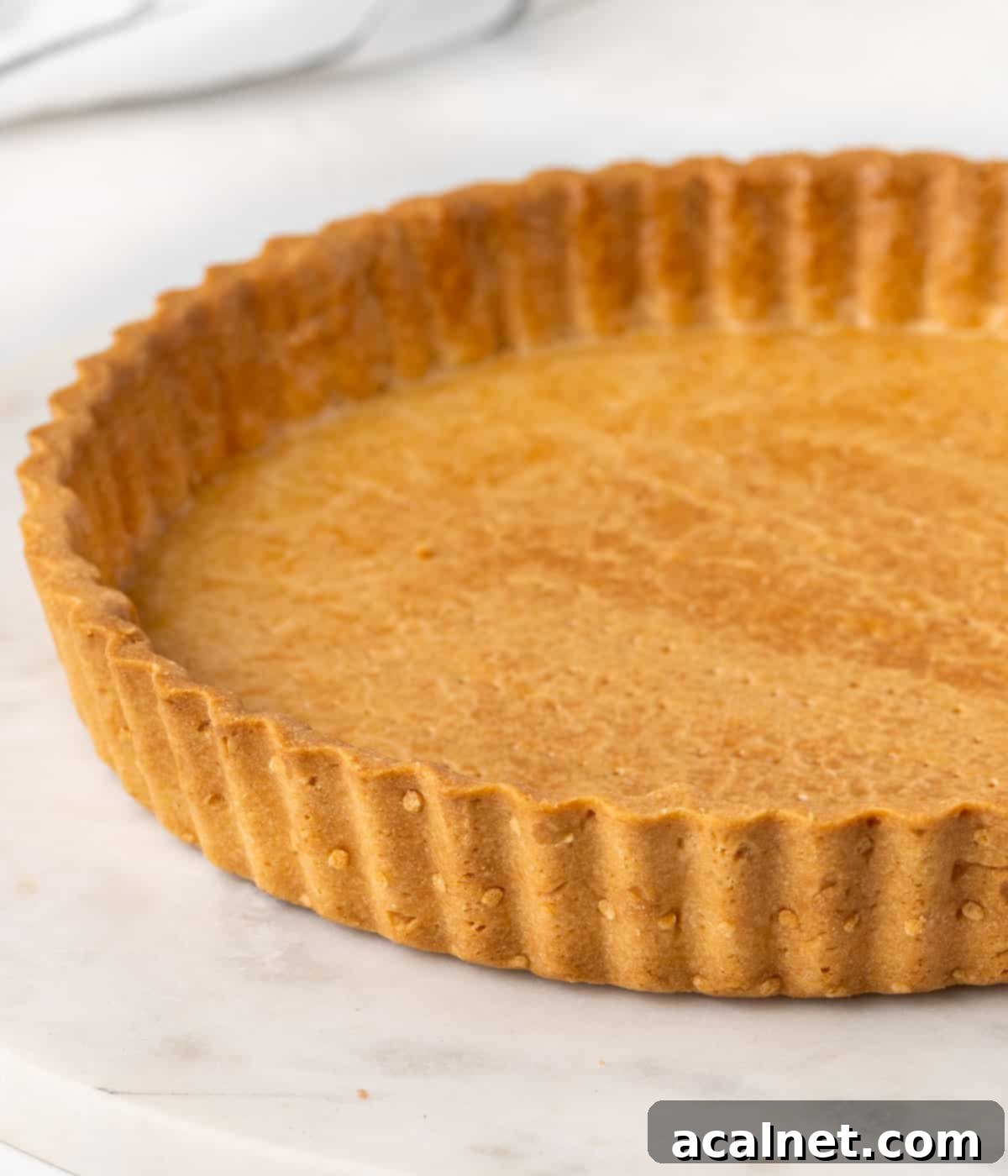
More Classic French Pastry Recipes
If you loved making this Pâte Sucrée, explore more delightful French pastries:
- Choux à la Crème: Light, airy cream puffs filled with delightful cream.
- French Chocolate Tart: Indulge in a rich, decadent chocolate experience.
- Easy French Crêpes: Thin, delicate pancakes perfect for sweet or savory fillings.
- Classic French Profiteroles: Small, crisp choux pastry balls typically filled with ice cream and drizzled with chocolate sauce.
- Sablé Breton Cookies: Buttery, rich shortbread cookies from Brittany.
- Dacquoise Sponge: A light, airy nut meringue often used as a cake layer.
- Choux au Craquelin: Crispy cream puffs with a sweet, crackly topping.
- Buckwheat Crêpes (Galettes Bretonnes): Savory crêpes, a staple of French cuisine.
Made this recipe?
Let us know if you liked it by leaving a comment below, and tag us on Instagram @a.baking.journey with a photo of your creation!
Recipe

Pâte Sucrée (Sweet Shortcrust Pastry)
Servings:
1
large Tart Pan (25 cm wide)
Author:
Sylvie
25 minutes
45 minutes
2 hours
3 hours
10 minutes
Print Recipe
Prevent your screen from going dark
Ingredients
- 100 gr ( 6 1/2 tablespoons) Unsalted Butter, soft, at room temperature
- 50 gr (1/2 cup) Icing Sugar, or Powdered / Confectioner’s Sugar
- 1 Egg, medium to large, at room temperature
- 40 gr (1/3 cup + 1 tablespoon) Almond Meal
- 200 gr (1 1/3 cup) Plain / All-Purpose Flour
- 1 pinch Fine Table Salt
Instructions
- Place the very soft butter in the bowl of your mixer with the Icing Sugar. Cream with the paddle attachment until smooth; about 2 minutes on medium speed.
- Add in the whisked Egg and Almond Meal. Mix on low speed until combined.
- Slowly mix in the Flour and Salt, stopping as soon as a rough dough comes together (see note 1).
- Transfer the pastry dough over a large sheet of baking paper and assemble it into a ball. Gently flatten the ball into a disk using your hands and do the “fraisage” (see note 2).
- Cover with a second sheet of baking paper and roll to a thickness of about 4mm (1/8 inch) with a rolling pin (see note 3). Place in the fridge to chill for at least 1 hour, or up to 24 hours.
- Take the pastry out of the fridge and leave it to come back to room temperature for about 5 minutes.
- Remove the baking paper sheets (see note 4) and transfer the pastry over the tart pan.
- Gently slide the pastry along the edges of the pan until it touches the bottom. Press it tightly against the bottom and edges of the pan (but without breaking it) to remove any air pockets. There should be no gaps between the pastry and the pan.
- Remove any excess dough using the rolling pin and/or a small paring knife (see note 5). Use any excess pastry to patch up holes, cracks or irregularities if needed.
- Place in the fridge to chill and rest for at least 1 hour, or up to 24 hours.
- Dock the pastry (poke the bottom with a fork). Preheat your oven on 160’C/325’F and place the pastry in the freezer in the meantime.
- To par-bake: bake for 15 to 20 minutes or until the bottom feels dry to the touch. Add the filling and finish baking.
To fully blind-bake: bake for 40 to 45 minutes, or until lightly golden. Leave to cool down completely before adding your choice of filling.
Video
Would you like to save this recipe?
We’ll email this post to you, so you can come back to it later!
Notes
- Do not overmix the dough here – you can stop as soon as you do not see large lumps or un-incorporated flour
- Fraisage: with the palm of your hand, gently press the dough out then pick it back and place back over the centre of the pastry. This process is used to insure all the ingredients are evenly mixed and you get the perfect texture.
- The best way to roll the pastry is to always roll in the same direction. Simply turn the pastry 90′ after each roll until you get a large circle. The pastry will be very soft – so easy to roll – but try not too roll it too thin. To check if it is rolled large enough, place the tart pan over and assess.
- To make sure the pastry can be easily moved away from the baking paper sheets: remove the top sheet of baking paper, place it back over the pastry, flip the pastry over and remove the second sheet.
- Roll the rolling pin over the top of the pan to cut off any excess pastry. You can also use a small pairing knife run parallel to your work surface to cut off the extra pastry.
Nutrition (per serving)
Calories:
1890
kcal
|
Carbohydrates:
201
g
|
Protein:
36
g
|
Fat:
107
g
|
Saturated Fat:
54
g
|
Cholesterol:
379
mg
|
Sodium:
117
mg
|
Potassium:
275
mg
|
Fiber:
10
g
|
Sugar:
41
g
|
Vitamin A:
2737
IU
|
Calcium:
163
mg
|
Iron:
12
mg
